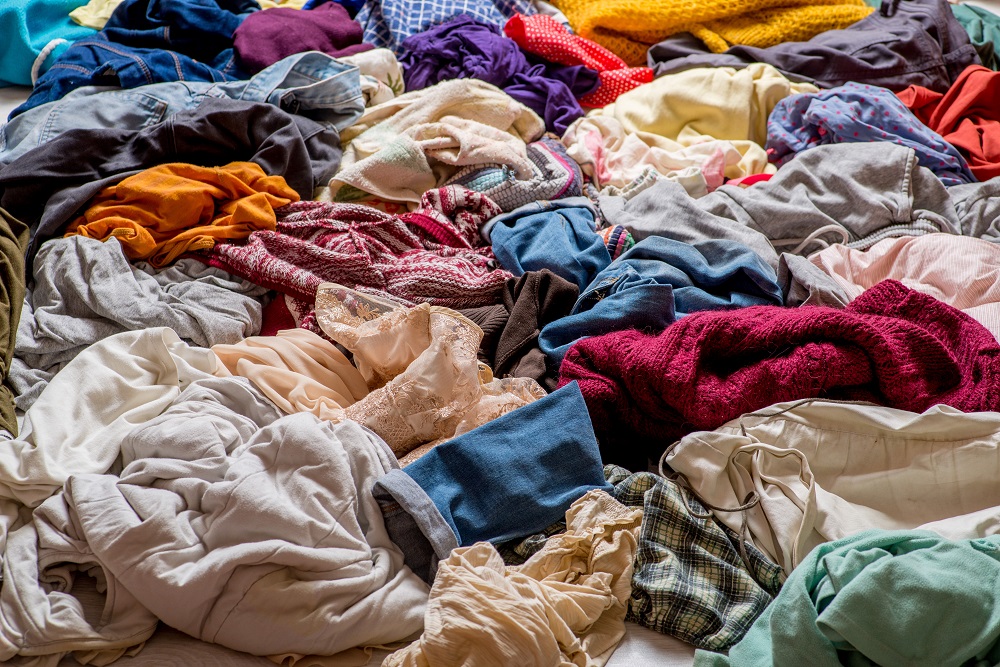
The fashion industry is responsible for about ten percent of our global carbon emissions with other impacts coming from the sourcing of materials, sweatshop labor, chemical processes, fossil fuel-based fibers, and vast quantities of water waste.
Once we bring home that cute outfit, however, we are responsible for what kind of environmental impact our used clothes might have. According to Bloomberg, the United States throws away up to 11.3 million tons of textile waste each year. When clothing is “thrown away”, it can take more than two hundred years for materials to decompose in a landfill. As fabric breaks down, it generates methane gas and leaches toxic chemicals and dyes into the groundwater.
What can we do with our unwanted clothing?
Hand-me-downs and clothing swaps are still some of the most environmentally friendly options to handle yesterday’s clothes, but taking your gently worn clothes to Goodwill, the Salvation Army, or a local charity can also give them a second (or third) life. Special used/vintage items that might be worth a little more can be resold through online boutiques like Poshmark, Bloom, or ThredUp.
Fast fashion’s environmental toll has consumers putting pressure on brands to operate more sustainably. Some companies are beginning to take responsibility for the after-life of their products with buy-back programs where they refresh and repair items for resale. If garments are too worn to be resold, they are upcycled into new clothing or can even be recycled into rags or fibers used for stuffing or insulation. A favorite shirt may be used to insulate a home or to create a plush sofa. A garment can have six or seven life cycles, rather than a short run from closet to landfill.
Here are some clothing collection programs:
- H&M’s Garment Collecting Program is accepting textiles for recycling again after taking a pause during the pandemic. They accept clothing in any condition, of any brand. Donated textiles are divided for rewear, reuse as raw material, or recycled into shredded fibers for insulation. In exchange, they offer a coupon toward your next purchase.
- REI’s Good and Used Program accepts REI members’ pre-loved gear if it is in good condition and previously sold at an REI store. They provide a shipping label for $6 or you can bring your items to a store. They will offer a gift card in exchange for qualifying items.
- Patagonia’s Worn Wear Program accepts Patagonia clothing that is still in good, wearable condition in exchange for credit toward purchases. They revive your used apparel and resell it at a discounted price. Bring the clothes to a store or get a prepaid shipping label on their website.
- Eileen Fisher’s Renew Program is offering a $5 reward card for any Eileen Fisher clothing, no matter the condition. The clothing can be brought to a drop box in the store or mailed to the company.
- Lululemon’s Like New Program allows customers to send back their gently used Lululemon leggings, tops, bags, and jackets to be refreshed and resold as used items on their website. In exchange, Lululemon offers an e-gift card (of $5-$25) toward future purchases.
- American Eagle Outfitters has partnered with the Give Back Box program. On their website you can print out a free shipping label, fill a box of gently used clothing of any brand, and they will send it to one of their charities.
- For Days’ Take Back Bag can be purchased for $20. They will mail you a bag with prepaid shipping and you can send all your old clothing from any brand. They accept all textiles, including socks, underwear, sheets, pillow cases, towels, linens, shoes, and handbags in any condition, even ripped, torn, or stained. You’ll get reimbursed with $20 of Closet Cash credit towards a purchase of sustainably-made For Days clothing.
Ultimately, one of the greatest impacts we can have on the fast fashion industry is to buy less and wear our clothes longer. Choosing higher quality fabrics, washing clothing less often, and taking the time to mend minor tears can shift our culture away from a disposable mindset, back to one where quality is valued and care matters.












